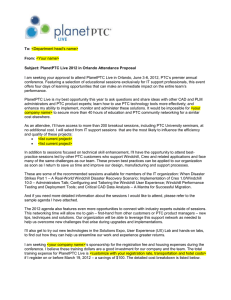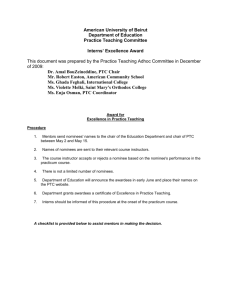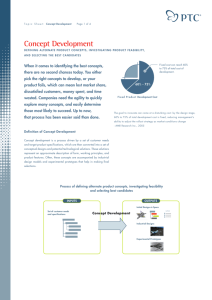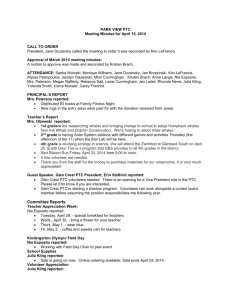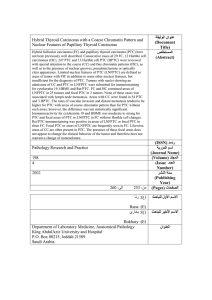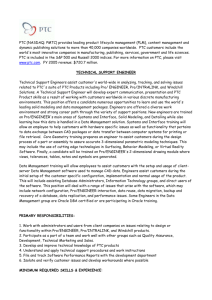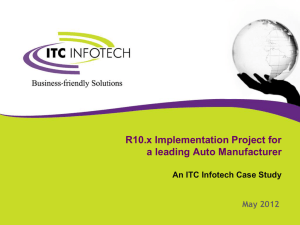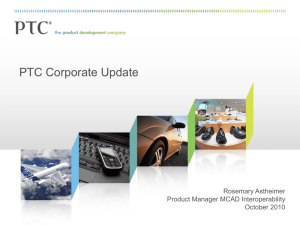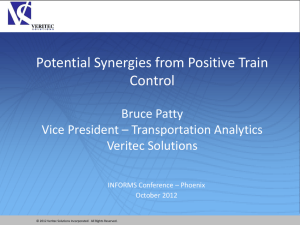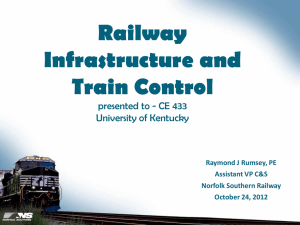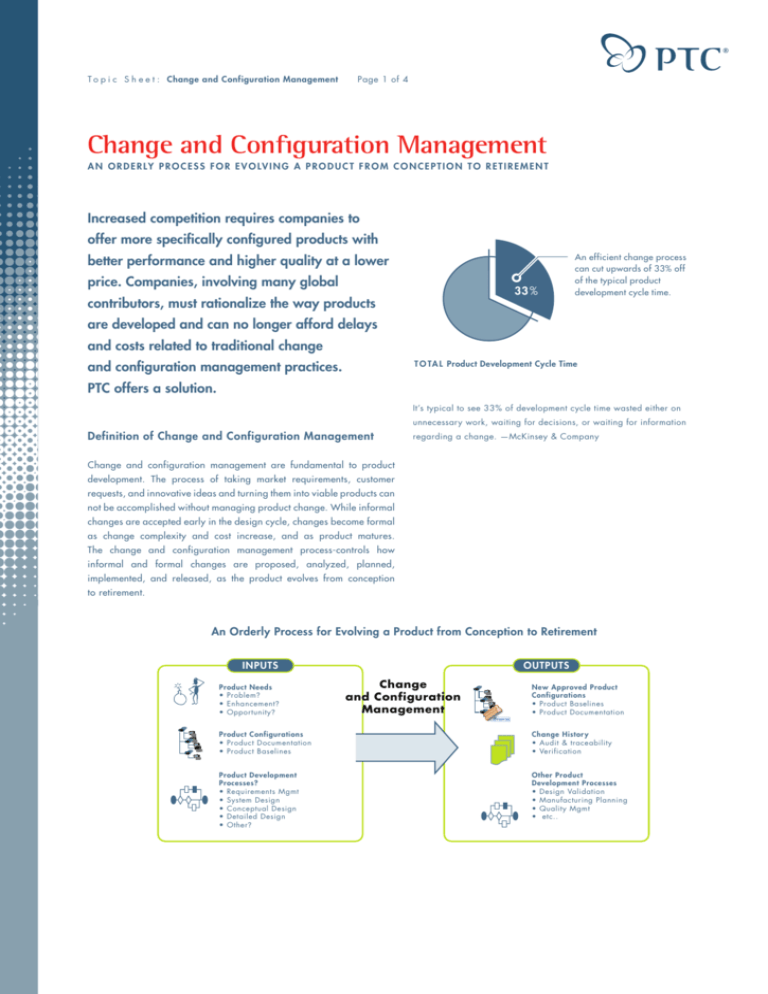
T o p i c S h e e t : Change and Configuration Management
Page 1 of 4
Change and Configuration Management
A N O R D E R LY P R O C E S S F O R E V O LV I N G A P R O D U C T F R O M C O N C E P T I O N T O R E T I R E M E N T
Increased competition requires companies to
offer more specifically configured products with
better performance and higher quality at a lower
price. Companies, involving many global
33 %
contributors, must rationalize the way products
An efficient change process
can cut upwards of 33% off
of the typical product
development cycle time.
are developed and can no longer afford delays
and costs related to traditional change
and configuration management practices.
T O TA L Product Development Cycle Time
PTC offers a solution.
It’s typical to see 33% of development cycle time wasted either on
unnecessary work, waiting for decisions, or waiting for information
Definition of Change and Configuration Management
regarding a change. —McKinsey & Company
Change and configuration management are fundamental to product
development. The process of taking market requirements, customer
requests, and innovative ideas and turning them into viable products can
not be accomplished without managing product change. While informal
changes are accepted early in the design cycle, changes become formal
as change complexity and cost increase, and as product matures.
The change and configuration management process-controls how
informal and formal changes are proposed, analyzed, planned,
implemented, and released, as the product evolves from conception
to retirement.
An Orderly Process for Evolving a Product from Conception to Retirement
INPUTS
Product Needs
• Problem?
• Enhancement?
• Opportunity?
OUTPUTS
Change
and Configuration
Management
New Approved Product
Configurations
• Product Baselines
• Product Documentation
Product Configurations
• Product Documentation
• Product Baselines
Change Histor y
• Audit & traceability
• Verification
Product Development
Processes?
• Requirements Mgmt
• System Design
• Conceptual Design
• Detailed Design
• Other?
Other Product
Development Processes
• Design Validation
• Manufacturing Planning
• Quality Mgmt
• etc..
T o p i c S h e e t : Change and Configuration Management
Page 2 of 4
Understanding the Need for Change and Configuration
Management
Benefits of an Optimized Process for Change
and Configuration Management
Many companies face challenges around the use of change and configu-
A flexible, responsive and efficient change and configuration manage-
ration management procedures stemming primarily from the fact that the
ment process improve a companys’ ability to compete. Typical benefits
the process is typically manual and paper-based. As a result, it is very
from improving the change and configuration management process
slow and bureaucratic.
may include:
An overly complex process coupled with a lack of users’ knowledge,
Improve Business Decisions
results in low process adoption. Changes are either avoided or the
• Replace legacy systems and applications with single
process is bypassed, and as a result the downstream documentation is
enterprise process
either incomplete or incorrect, and valuable design and configuration
history is lost, which causes problems in downstream product develop-
• Enable reliable best practices process approaches supporting
ment stages (e.g., Manufacturing, Sourcing).
The process is further complicated due to companies using multiple
Increase Innovation
systems managing product information and different applications to aid
• Increase overall engineering time by reducing the change related in the change process execution. As a result it is difficult to find, analyze,
minor and major changes
administrative workload
monitor and provide status of change information.
• Minimize rework and work task coordination across the extended An increased number of global and external contributors in the product
enterprise by automating the process
development process complicates change coordination and information
access across multiple organizations. Companies must consider how
Reduce Product Cost
change and process is executed in a highly distributed environment and
• Early knowledge of changes allows manufactures to better how product data and intellectual property is secured as change informa-
prepare for change and minimize inventory
tion is delivered to and from contributors.
Attain Higher Quality
As product complexity, variants, and options increase, so too does the
• Ensure product quality across the product lifecycle by improving need to manage change and product configurations. Inadequate config-
process adoption
uration management practices make it difficult to capture important
product milestones, track incremental product updates and make updates
• Reduce manufacturing related issues by incorporating quality to configurations impacted by change.
improvement changes early in design process
Reduce Time-To-Market
• Reduce product development cycle time and downtime awaiting change decisions by providing accurate documentation
of changes
T o p i c S h e e t : Change and Configuration Management
Page 3 of 4
The Solution – PTC’s Product Development System
PTC provides an integral and automated change and configuration
process with all the necessary tools to accommodate change throughout
1
Product
Configuration
Identify Need
the product lifecycle. In general terms, the process has 4 major steps:
Identify the Need, Investigate the Need, Plan the Change, and Implement
2
the Change.
Investigate Need
Verify & Validate
Process
Clarify
1. Identify Need. The goal of this step is to enable product develop-
Need
Approval?
ment contributers and external parties to report problems and enhancement to products. The information is captured using Windchill Problem
Reports, where the submittor describes the “Need”, identifies the affected
3
Plan Major
Change
product and suggests solutions. Once submitted, the problem report is
sent automatically to a designated reviewer for validation and approval
Plan Minor
Change
Re-Work
or rejection.
Approve
System Design
Concept Design
Detail Design
Verify & Validate
2. Investigate the Need. When one or many problem reports have been
approved, the change team may now proceed with an in depth change
4
Implement
Change
investigation. The change investigation is captured in an Engineering
Change Request and the goal is for product experts to accurately assess
the scope of the change, feasibility, downstream product impact, solution
proposals, cost and business justification. Upon completed investigation the process may follow either a formal process, involving review
and approval by a cross-functional team (Change Review Board), or
the process may follow a less formal process, not requiring approvals.
System Design
Concept Design
Detail Design
Verify & Validate
Review / Audit
Change
Re-Work
Approve
Release Change
Product
Configuration
Change History
Whether a change follow a formal process path or not generally depend
on change complexity or product maturity state.
Change and Configuration Management Process Flow. The general flow
3. Plan the Change. The goal of this step is to plan the detailed imple-
depicted here may be adapted in support of industry-specific change
mentation of the change including schedule, work tasks, and resources.
and configuration management needs. Particular adaptations are often
The change planning is captured in an Engineering Change Notice (ECN).
undertaken for the Aerospace/Defense and Automotive industries.
As part of the planning, the implementation team will decide how to
incorporate changes to impacted product configurations, new or revised
parts, and how to manage obsolete parts. If the change follow the formal
process the implementation plan has to be reviewed and approved by a
cross-functional team (Change Implementation Board).
4. Implement the Change. The goal of this step is to implement, review,
audit and release the change. Upon approval of the implementation plan,
all the work tasks per the implementation plan are automatically delivered to the designated users. When a work task is completed a designated reviewer is automatically notified to review and approve actual
vs. planned change. When all work tasks are approved, a final review
and audit notice is automatically sent to a designated reviewer, typically
the engineering manager, who will perform a final review and analysis
of the entire ECN based on actual vs planned changes, effective date of
the change, disposition of obsolete parts, and new and updated product
configurations. Upon approval, the change will be released.
T o p i c S h e e t : Change and Configuration Management
Page 4 of 4
Critical Capabilities
The PTC Product Development System offers the following capabilities,
necessary for optimization of the change and configuration management process:
• Out-of-the-box change and configuration management process
with support for informal and formal changes
• Automated, closed loop process enabling instant access to change information for analysis, review, approval and
implementation
• Ability to describe, classify and prioritize Problem Reports and Enterprise Change Requests
• Ability to document, review and approve change business Initiating a change request via a problem report in Windchill PDMLink.
justification, impact and analysis
• Ability to effectively plan and manage change implementation using Engineering Change Notices
• Facilitate change review of proposal and planned implementation with board of advisor/approvers
• Manage and capture as planned and as-released product configuration baselines
• Automatic notification of downstream consumers of change
information of impeding changes and effective dates
• Real-time change tracking, audit history, electronic signatures
and statistics
PTC – Uniquely Qualified
Optimizing your change and configuration management process not
only requires superior technology, it also requires companies to change
An automated and
optimized change
and configuration
management process
not only requires
superior technology,
it also requires the
ability to understand
how it impacts
critical business
processes and people
in the organization.
the way they work on a day-to-day basis. Just as important, companies need to ensure everyone across the organization understands and
adopts the new processes and technology.
After 20 years of deploying process and technology improvements
across thousands of customer sites, PTC has a worldwide Global
Services team that understand what’s required for companies to be
successful.We offer solutions that include the right blend of process
consulting, system implementation, and education services so customers realize the most value from their PDS investment. We implement
industry best practices that fully leverage PTC technology, so companies
take advantage of its potential while avoiding costly customizations.
Plus, each of our solutions incorporates a unique training approach that
accelerates the adoption of new technology and processes.
© 2006, Parametric Technology Corporation (PTC). All rights reserved. Information
described herein is furnished for informational use only, is subject to change without notice,
and should not be construed as a guarantee, commitment, condition or offer by PTC. PTC,
the PTC Logo, Pro/ENGINEER, and all PTC product names and logos are trademarks or registered trademarks of PTC and/or its subsidiaries in the United States and in other countries.
All other product or company names are property of their respective owners.
2067-ChangeMgnt-TS-1 2 0 6


